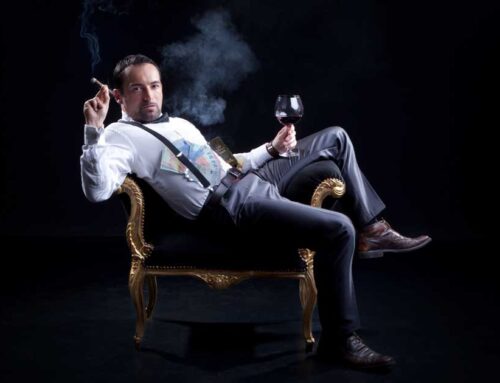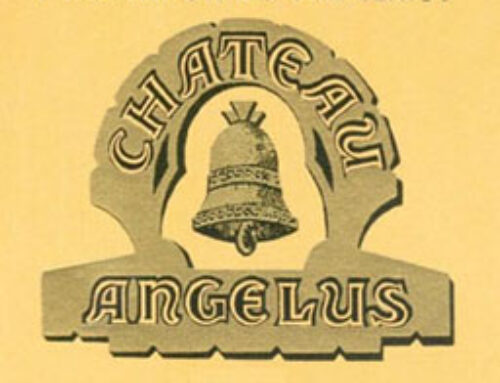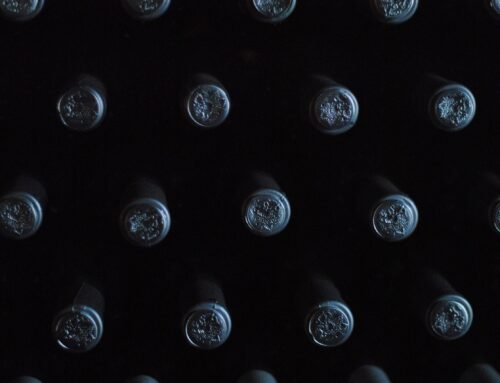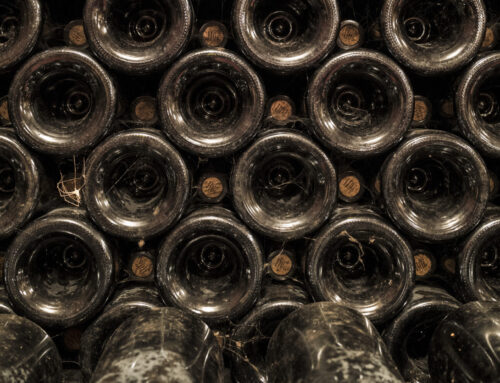The history of modern viticulture in China dates back to the late 19th century. In 1892, Chang Bishi (1841 – 1916) founded Changyu, China’s oldest winery, with some vines from the USA in Shandong. Today, Changyu is the largest wine producer in China, with numerous wineries in various regions generating annual sales of around 1 billion euros. But it is only in recent years that an enormous dynamic has come into the Chinese wine scene, which can perhaps be compared with the 1970s in Napa Valley. The up-and-coming Helan Mountain wine region in Ningxia, which became China’s first official appellation in 2003, plays a central role in this. Among the great pioneers of modern viticulture in China were Mr. Wang Fengyu, Mr. Li Demei, and Mr. Rong Jian, who were the first to discover the great potential of Helan Mountain in the 1980s. China’s wine-growing regions stretch roughly around the 40th parallel from west to east throughout the country. In the far west is Xinjiang, where mostly table grapes are grown and some very good wines are also produced. The wine route continues to the east, via Gansu, which has a wine-growing tradition of over 2400 years, and whose wines are sung about in ancient Chinese poems. Further east lies the already mentioned Ningxia, which is considered today the most promising wine-growing region of China. This is followed by Shanxi, where mainly mass-produced wines are made, but Grace Vineyards is also home to one of China’s best-quality wineries. Wine is also grown in the coastal provinces in the far east. Jilin in the far north, where wine has been produced for 100 years, is known for its ice wines, though the true epicenter of China’s most famous ice wines is a little further south in Liaoning, with Korea Bay to its south. Hebei and Tianjin lie around Beijing and border Korea Bay to the west. Here, large quantities of wine are produced in particular. Of note here is Domaine Franco Chinois, which grew out of the experimental winery called Sino-French Demonstration Vineyard, and Amethyard, which produces a good Cabernet Sauvignon as well as a considerable Marselan. And then there is Shandong, on whose peninsula between the Yellow Sea and the Gulf of Bohai most of the wineries are located, and where 40% of Chinese wines are produced. Shandong has a monsoon climate with warm, humid summers, so soils with good drainage are crucial for growing grapes there. Among Shandong’s best wineries is Chateau Nine Peaks, founded in 2008 by Frankfurt-based investment banker Karl Hauptmann, who previously established the Bessa Valley winery with Count Neipperg in Bulgaria. The vines of Chateau Nine Peaks were imported from France. The Cabernet Sauvignon Reserve is of remarkable quality. Finally, far to the southwest of China, there is the wine-growing region of Yunnan around the 25th parallel, where China’s most expensive prestige wine, the Ao Yun from LVMH, is pressed in the world’s highest locations on the foothills of the Himalayas. At an incredible altitude of 2200 to 2600 meters, its vines are located in over 300 small vineyards, which are cultivated entirely by hand by local winegrowers. 2013 was the first vintage – but the quality is nowhere near the called price of around 250 to 350 EUR, I had rated the wine 89+/100. The most exciting, dynamic, and best wine-growing region in China is Ningxia with the Helan Mountain appellation. To better understand this region, I spent a week on site in May 2019. Helan Mountain is located 900 km west of Beijing in the Hetao Plain, a gigantic loess plain next to the Gobi Desert through which the Yellow River meanders. It lies directly at the foot of the Helan Mountains (Helan Shan), a mountain range more than 200 km long and over 3500 m high, which separates the megacity of Yinchuan from the Gobi Desert.
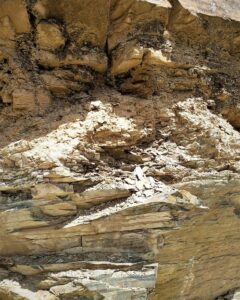
Mit Löss durchsetzte Gesteinsformation im Helan-Gebirge. (c)weinkellerschweiz.ch
However, the vineyards are not slopes but are located on the high plateau of the Hetao plain at an altitude of just over 1200 meters. The climate there is very dry. Thanks to the Yellow River, which feeds large-scale irrigation systems, a lot of agriculture is practiced here. Due to the altitude and the desert climate, the nights are very cool even in summer, while during the day the thermometer can climb to 40°C. Since the mountain range runs in a north-south direction, it offers no protection in winter from the icy air masses that flow south from Siberia across Mongolia. Temperatures below -30°C are not uncommon in winter. Therefore, the vines could not survive a winter here, which leads to the following peculiarity in vineyard care: The trunks of the vines are raised to horizontal about 30 cm above the ground, and every fall, in mid-November, the vines are tied further towards the ground and buried before the onset of winter. This protects the vines from cold death. Then, at the end of March or beginning of April, they have to be dug out again by hand. Whole armies of workers – 3 to 10 pairs of hands per hectare – need 5 to 15 days to do this, depending on the winery.
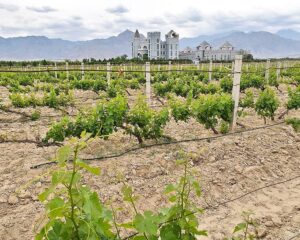
The vines are raised to horizontal just above the ground so that they can be completely covered with soil in winter to protect them from frosts down to -30°C. (c)weinkellerschweiz.ch
Since the growing season is so short, it is important not to lose time. Therefore, in order to accelerate sprouting, the vines are irrigated for 18 hours each two days after uncovering. The gigantic effort of digging in and out is only possible because of the low wage level of unskilled migrant workers in China, yet it represents a not inconsiderable cost factor. Only 10 years ago, such a farm worker earned only 60 RMB per day, today it is already 150 RMB, about 20 EUR per day. For a small winery with just under 20 hectares of vineyards, this is a not inconsiderable expense, which, thanks to rising wages, will probably soon reach 100,000 euros a year in the future.
How it all began at Helan Mountain
How did it all begin at Helan Mountain? Wang Fengyu was an official of the Ministry of Agriculture in Yinchuan who was studying the geology of this region. The rather rugged Helan Mountains are an intraplate orogen that penetrated the Yinchuan Plain relatively rapidly in the last 50 million years, but probably only about 10 million years ago. This resulted in mineralogically diverse rock formations at the base of the mountains, which this region has in common with the famous Napa Valley. Among other things, shale is found in the bedrock. Wang Fengyu recognized the potential of this combination of soil and climate with hot days, cool nights, and little rainfall for viticulture. In 1984, long before viticulture began in this region, Fengyu Wang planted the first vines in his private garden and began experimenting. In 1998, Helan Mountain Winery was established, the first major winery in this region. After his retirement, Fengyu Wang, together with Rong Jian and Prof. Li Demei, founded Helan Qingxue in 2005, which received worldwide attention in 2011 when it’s 2009 Jia Bei Lan became the first Chinese wine to beat out the overwhelming international competition and win a coveted award at the Decanter World Wine Awards.
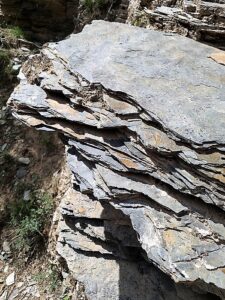
Das Helangebirge ist tektonisch noch aktiv und mineralogisch sehr vielseitig. Auch Schiefer kommt vor. (c)weinkellerschweiz.ch
In the years that followed, countless wineries were established in Helan Mountain, and the area under cultivation grew explosively. This is because the Chinese government recognized the economic value of top wines and wants to use local wines to push back the expensive imports from France. Today, there are around 100 wineries in the region, and the government has ambitious plans to expand the vineyards on Helan Mountain to 67,000 hectares.
巴黎的判决 2.0
As is well known, top wines need more than just good soil and climate. Above all, the skill and passion of the winemaker are decisive. Most of the wines grown in this region today are of simple to inferior quality – the same can be found in Bordeaux, for example. But a handful of passionate winegrowers and winemakers have founded outstanding wineries in recent years, whose wines can compete in the international upper league. Not in the top tier of the 1er Grand Crus from Bordeaux or the top wines from California, but definitely on the level of decent Bordeaux 3ème Grand Crus such as Lagrange from St.-Julien. This is especially remarkable because all of these winemakers have less than 20 years of experience with the terroir. And so, for many of these wines, there is a clear evolution in quality over the last few years. I won’t be surprised if, in 10 or 20 years, wines from Ningxia give good prestige wines from Bordeaux and Napa a run for their money in blind tastings – Judgment of Paris 2.0, or better: 巴黎的判决 2.0. Almost all Helan Mountains winemakers still focus on Bordeaux grape varieties, especially Cabernet Sauvignon and – to a much lesser extent – Merlot, while Chardonnay predominates among white wines. However, the growing season for Cabernet Sauvignon is very short here. Therefore, the wines do not infrequently show a distinct note of green bell pepper. Meanwhile, there are voices that say other grape varieties are better suited for this region. I have to agree with this because in my experience, only a few top producers manage to produce good Cabernet Sauvignon in Ningxia. A blend with Merlot suits this region much better. However, Cabernet Gernischt (Carmenère) and Marselan often produce very good wines in China. Marselan is actually considered THE grape variety of China, the “signature grape of China,” as Decanter called it. The best Marselan I have drunk was not from France but from Hebei. Here, however, I stay in Ningxia and would like to present some of the top wines of this region.
The wineries
Kanaan Winery:
Wang Fang, the winemaker, studied in Germany and lived there for over 10 years until she returned to her homeland to become a winemaker. Her father Fengyu Wang, the above-mentioned pioneer of viticulture in Ningxia, was to blame. When Fengyu asked his daughter if she didn’t want to produce wine here, too, she spontaneously agreed and returned from Germany to her first home. 18 hectares have now been planted at the Kanaan Winery. The cellar technology is modern and functional; thanks to the low average annual temperature, which is due to the long and icy cold winters and cool nights, the deep cellars where the chai and bottle storage are located are hardly warmer than 10°C, even in the very hot summer. Kanaan Winery has six wines in its official program, two white and four red. The Riesling is a bone-dry character wine with chalk minerality and relatively little fruit, dominated by grapefruit. The Semi Sweet White Wine is a blend of Riesling, Chardonnay, and Sauvignon Blanc, and the reds are based on Cabernet Sauvignon. The Wild Pony is from young vines and contains a good 10% Merlot and some Cabernet Gernischt. It is fruit-driven and should be drunk young. The Pretty Pony with about 10% Merlot is powerful and concentrated and from pleasantly ripe vines, which is not a given with Cabernet in Helan Mountain with its relatively short growing season. Here, a steady improvement in quality over the past few years is noticeable.
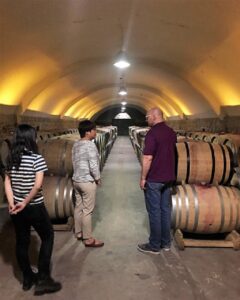
Wang Fang (Mitte) in ihrem Chai. In einem tiefen Keller pendelt die Temperatur im Jahresrhythmus exakt um die Jahresdurchschnittstemperatur am Boden, je tiefer der Keller liegt, desto kleiner ist die Temperaturamplitude um diesen Mittelwert. Die Jahresdurchschnittstemperatur in Yinchuan beträgt 8,9°C. (c)weinkellerschweiz.ch
Wang Fang, who is also called Crazy Fang by her friends, told that all even vintages turned out better than the odd ones. With its power and fullness, and the dense but ripe tannins, the Pretty Pony can hold its own next to good Grand Cru from Bordeaux or successful Californians in the league of a Ridge Estate or Napanook. The Black Beauty with about 30% Merlot is finer, more elegant, shows more structure, and is similar in character to Ch. Lafite, even if it does not reach its quality. Positioned above it is the expensive Crazy Fang, a pure Cabernet Sauvignon that ages for a long time in the winery’s cool cellar before being released to the market. 2011 is the last and so far only vintage currently available. About 120 EUR are called ex-winery for this flagship wine. For his own consumption, Fang also pressed the Pink Pony, a simple but successful dry rosé, which has meanwhile also been launched on the Chinese market. I see Kanaan among the top 5 wineries of Helan Mountain in terms of quality. 2017 Pretty Pony. Drank 2019: While the less successful wines from numerous other wineries in the region remain lean, this Pretty Pony counters the bell pepper and pepper spice with tremendous concentration and dense fruit. The fruit lacks the opulence and sweetness of Legacy Peak’s Kalavinka. Sour cherry, blackberry, and mulberry are here. Cassis as well. The wood is skillfully and carefully used, the tannins from the berries and the barell melding into one. Hedonistic power and remarkable, if still somewhat coarse, structure. On par with the terrific 2016. 92/100. 2016 Pretty Pony. Drunk 2019: A fantastically accomplished wine, proving the potential of this plateau for great wines. 85% Cab, 15% Merlot. 20 months in 60% new and 40% once pre-aged small wood. The wine is just in a dream fruit phase, the tart fruit of cassis and black cherry is complete without kitsch, in the bouquet magical fresh menthol and some grill aromas of red bell pepper and steak. Fleshy on the palate, it is powerful but with a sinewy structure. The tannins have a youthful grip but show nice physiological maturity. The acidity fits like a tailored suit. A great wine that I like better than Legacy Peak’s more opulent Kalavinka. 92/100. 2014 Pretty Pony. Drank in 2018. very spicy and powerful, but not fat. Dark fruit, Christmas spices, also some fully ripe peppers. A very subtle eucalyptus note on top. Nice juicy tannin. Very good wine! 90/100 2013 Pretty Pony. Drank in 2017. won the ‘Asia Regional Gold Trophy’ at the 2015 Decanter Asian Wine Awards as well as the ‘Best China Red trophy’. 90% Cabernet Sauvignon, 10% Merlot. Very spicy bouquet with cinnamon, allspice, and cedar. Dark fruit, black cherry, plum, and cassis. The wine is stout, has power, and shows an almost savory spice on the palate as well, the tannins give it the grip needed to keep the ripe blue fruit in check. The wood was used with skill, as in a proper Bordeaux. I liked a little less wood, however, even better. 89/100. 2016 Black Beauty. Drunk in 2019, Black Beauty sits at the second highest position in Kanaan’s portfolio, with only the extremely rare and very expensive Crazy Fang above it. In 2016, there is not much difference with the Pretty Pony; at this youthful fruit stage, both are equally fun at the moment. The Pretty Pony, which costs only about half as much, is a bit fuller, while the Black Beauty shows more structure and minerality. In the air, one metamorphosis follows the next; the wine starts compact and with tart cassis to almost biting menthol, and the fruit in the bouquet slowly turns towards black cherry. The menthol disappears and gives way to a blend of eucalyptus and citrus. Charcoal and graphite as well. Grip the wine on the palate without being very astringent. Rather, there is a fresh, almost lemony acidity here. The fruit is more subtle on the tongue than on the nose, fresh, tart, without opulence or sweetness. Impressive structure. 93+/100. 2014 Black Beauty. Drunk in 2019, it’s clear here that Black Beauty is to Pretty Pony as Dominus is to Napanook in taste. These are not first wine and second wine. Rather, this is structure and elegance (Black Beauty) versus power and opulence (Pretty Pony). And that’s exciting. 70% Cab and 30% Merlot are in the Black Beauty. The bouquet is wonderfully fine, balanced, and more tart than sweet. Really great papillary tennis on the palate, with fresh fruit, mint, and eucalyptus. Wonderful tension with very fine structure. Deliciously dry, there’s no residual sugar tail to simulate volume. There’s not a gram of fat either, unlike the baroque Pretty Pony, this wine is a scalpel. 94/100. ex winery the wine costs 75 EUR, in Shanghai just under 100. and it is actually worth that. 2013 Black Beauty. Drunk in 2019. cabernet sauvignon and merlot. Some Chinese bell pepper, but also tart dark berries, blackberries, and mulberries to cassis on the nose. Freshly opened there was still a noticeable oak note, but after an hour or two in the decanter, there is now just a delicate hint of cedar. Powerful, more mineral than fruit, with a very stable structure. Still a bit unpolished. Bone dry, the tannins are still lacking the polish of cellar maturity. A really good wine with potential. 92/100
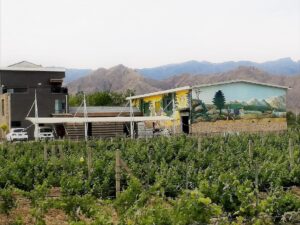
The Kanaan Winery is located at the gates of the megacity Yinchuan at the foot of the mountain range. (c)weinkellerschweiz.ch
2018 Riesling. Drunk 2019. this is simply a very good Riesling. Bone dry, full of minerality, very little fruit. Very little tangerine, pineapple, or lemon. More limestone than slate. Lean body, decent acidity. Super Riesling from China! Independent, not a copy. 89/100 2017 Riesling. Drank in 2018. a dust-dry, very mineral Riesling. The bouquet is not very riesling typical, with its hint of pear to lime and cool chalky marl you could mistake it for a silvaner. The chalky minerality continues on the tongue, with very little lime and lemon here. The tight, steely, and purist structure would also suit a Chablis. The acidity is not too biting, so this Riesling does not seem unbalanced or too harsh despite the total absence of residual sugar and extract sweetness and despite its grippy minerality. Good 88/100. a remarkably mature and characterful Riesling. 2015 Riesling. Drunk in 2018. bergamot and lime, pebbles, also a discreetly resinous pinecone scent reminiscent of Viognier, which goes from the back, so retronasal rather riesling typical towards petrol. A bit fat and low in acidity, which is why it should be well chilled. 87/100 2014 Riesling. Drunk in 2018. smells very dry, restrained, with lime and pebbles. Wonderfully dry, no residual sweetness at all, more mineral than fruity. Lime zest, reminiscent of a wood-free Chablis rather than Riesling in the finish. This is remarkably good. 88/100 2017 Semi Sweet White Wine. Drunk in 2019, Riesling, Chardonnay, and Sauvignon Blanc. It has about the residual sweetness of a Riesling Kabinett from the Mosel but is infinitely more dangerous at 13 revs. The wine is clean, very fruity on the nose, with lots of ripe pear and pineapple. If you know it, you’ll notice both Riesling and Sauvignon Blanc. Despite its sweetness and fruit, there is a hint of chalkiness on the palate that distinguishes the winery’s brutally dry, mineral Riesling. 83/100
Legacy Peak:
Legacy Peak is also one of the top 5 wineries in Ningxia for me. The first vines were planted in 1997. The vineyards are located right next to the 50-square-kilometer, 1000-year-old Xixia necropolis, one of the world’s largest burial sites. From the vineyard, one can see the countless tombs, which from a distance look like termite mounds, and the “Chinese pyramids” of the imperial family, including the tomb of Li Yuanhao, the founder of the Xia dynasty, which is over 20 meters high. For me, Liu Han, Legacy Peak’s owner, and wealthy architect, came to the winery, joined by Steven, the cellar master, via video conference. At Legacy Peak, they have developed their own grapevine training. Foliage is pruned 2-3 times per season, with a green harvest once to reduce yield. To provide enough soil, the rows of vines are spaced 4 meters apart, which facilitates digging in the vines in the fall and ensures good aeration. In combination with the very dry desert air, this ensures very low fungal pressure. Therefore, there is hardly any need for spraying. In recent years, however, the amount of precipitation in August has increased significantly, which means that rot must also be combated at times. The vintage differences do not come from temperature differences, but from the different amounts of precipitation.
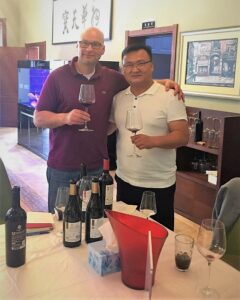
Liu Han (right) made his considerable fortune as an architect and then invested in the fledgling Legacy Peak winery, which he took over from his father. (c)weinkellerschweiz.ch
Legacy Peak has four wines in its portfolio, one Chardonnay and three Cabernet Sauvignons, including a blend with Merlot. The Chardonnay is closer to its Californian siblings than to those from Burgundy, the wines have powerful fruit, are buttery and full-bodied, and with 2 – 3 g/l residual sugar they are not powder-dry, although one should not yet speak of residual sweetness. Only 3,000 – 4,000 bottles of Chardonnay are produced per year, 2013 was the first vintage to be released. While the first vintages were aged in mostly new wood, 2017 went into once-pre-aged barrel for 5-6 months. The vines, now 24 years old, are among the oldest in this wine-growing region. The Chi Yu Cabernet Sauvignon, priced at around 45 EUR in China, comes from 16-year-old vines and is aged for 15-18 months in barriques. Above this is the Kalavinka Cabernet Sauvignon-Merlot, for which a good 80 EUR is charged in China. Despite its lush richness, it is one of my favorites among Chinese wines, always showing a beautiful opulence with ripe fruit and considerable structure. From 24-year-old vines, the wine is aged for 22-24 months in 80% new French barriques from 6 different Tonnelier’s. At the top of the portfolio sits the Family Heritage, a pure Cabernet Sauvignon of which less than 3000 bottles were produced in the year. 2017 Chardonnay. Drunk in 2019, I’ve tasted my way through many Chinese Chardonnays, and all have been more or less terrible. With Legacy Peak’s Chardonnay, everything is different. There is opulence here, with yellow fruit, butter, the scent of white flowers, and some popcorn. But then, with a bit more air, there’s a hint of dried herbs and a mineral nerve from limestone marl. Although under 3 g/l of residual sugar, it shows oily, glycerinic sweetness on the tongue that contributes to the voluminous, baroque mouthfeel. A Chardonnay as it was fashionable in California 10, 15 years ago. 90/100 2015 Chardonnay. Drunk 2019: California style, with a buttery bouquet, sweet corn, coconut, cream, Mirabelle, and some banana too. Creamy on the palate, with some sweetness (2.8 g/l RZ) and Californian richness. 89/100 2016 Chi Yu Cabernet Sauvignon. Drunk in 2019. nice ripeness, only discreetly some red bell pepper can be felt, alongside Mediterranean herbs and ripe blue plum. The fine spice from the wood, nicely ripe, soft tannins. 91/100 2013 Chi Yu Cabernet Sauvignon. Drunk in 2018, I had the wine carafe for 5 hours and chill at around 15°C. The wine is on the fruit-driven side, even if the bouquet shows oriental spices, licorice, and sandalwood. On the palate dried fruit and fresh pomegranate, blueberries. Also, this typical bell pepper tone, which seems different from many new world Cabernets, and by which – with more practice and a little luck – I might blindly recognize a Chinese wine someday. The acidity is fresh, the tannins atrophied and completely inoffensive, but the silky texture is just gorgeous. The wine does not quite come close to the denser, more concentrated Kalavinka. 90/100. 2014 Kalavinka. Cabernet Sauvignon and Merlot. Powerful, with ripe, sweet fruit and a tart spiciness typical of this region, half dried herbs of Provence, half grilled peppers. With air also some bitumen. 91/100. 2013 Kalavinka. Drank in 2018, for five hours in the decanter. Powerful, with ripe fruit and nice spice coming from the skillfully applied wood. The black cherry fruit, with its ripeness, reminds me more of Italy, of Brunello than of Bordeaux, which is the model for these wines from Ningxia. The tannins are wonderful; massive indeed, but juicy and rounded. World-class is that. 92/100. 2015 Family Heritage. Drunk in 2019 at the winery. The flagship wine is a pure Cabernet Sauvignon of which only 2600 bottles were produced. A bottle of great wine with terrific structure. Freshly opened toasty notes on the nose, the fruit with tart cassis, sour cherries, and fully ripe blackberries. Discreetly some red bell pepper. Even more compelling on the palate than on the nose, showing plenty of resilience here, more structure than the more opulent Kalavinka with its riper, fuller fruit owed to Merlot. The Family Heritage is sinewy, mineral, with young fruit, it seems balanced and powerful. 93/100 At home to the Skirt Steak a whole bottle re-tried: Is the Family Heritage really that good? Absolutely! A great wine, full of tension, with brilliant fruit and precise acidity. This is one of the best wines in China, which can take on good Bordeaux. 93/100
Silver Heights:
Gao Lin is another pioneer from Helan Mountains. In 1999, he bought Cabernet Sauvignon vines from France and planted his first plot. He convinced his daughter Yuan (Emma) to study enology at the University of Bordeaux. She completed internships at several châteaux, including Calon-Ségur, whose cellarmaster Thierry Courtade she married in 2003, and with whom she returned to Ningxia in 2005. 2007 was the first vintage of Silver Heights. The Family Reserve Chardonnay is a Burgundian wine in the style of a Puligny-Montrachet with good structure and well-dosed richness. The Summit, made from 2/3 Cabernet Sauvignon and 1/3 Merlot, is a wonderfully cool-mineral wine with fresh fruit reminiscent of a blend of top Chilean wine Seña and a Pauillac. At the top, is Emma’s Reserve, a pure Cabernet Sauvignon bottled only in magnums.
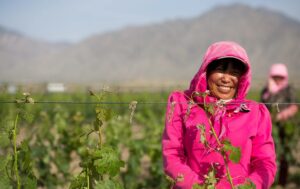
Harvest workers in Silver Heights (c)silverheights.cn
2014 Family Reserve. Drunk 2019. 60% Cabernet Sauvignon and 40% Merlot aged in 1/5 new and 4/5 used French oak barriques. Spicy green nose, bay leaf, allspice, green garden herbs, lemon. Also, the paprika tone is typical of Chinese CS. Nicely dry, the wine dispenses with the touch of residual sugar that feigns volume without obvious sweetness, often found in Chinese reds. Sinewy, without a wood crutch, with restrained tannins, which goes well with the lean body. A very good wine that could improve a bit with more maturity, but light years behind The Summit. 89/100 2015 The Summit. Drunk in 2018, Emma Gao let the wine age for a year in 50% new and 50% once-pre-aged French oak barriques. It’s good! It reminds me of a young Seña. Fresh fruit – black currant, some sour cherry – with eucalyptus and subtle dark toasty notes dominate the bouquet. This is already very coherent! In addition, the mineral scent of graphite or pencil lead. A similar picture on the palate: nicely sinewy, taut, showing a minerality similar to the Seña, which goes in the direction of the characteristic Lafite minerality. Pleasant acidity, fine-boned but nicely pronounced structure. The tannins are almost delicate, not dominating the finish of this still young wine, but giving a fine tannic grip. A decent amount of Merlot, Legacy Peak’s Kalavinka already showed, seems to do Helan Mountains wines well. What a positive surprise, especially in view of a – especially for Chinese conditions – not exaggerated price (about 60 EUR in China). Good 93/100.
Helan Qingxue:
As mentioned above, Helan Qingxue is one of the region’s trendsetters, the Jiabeilan was the first Chinese wine to attract international attention for its quality. 2014 Jia Bei Lan. Drunk 2018. 80% Cabernet Sauvignon, 15% Merlot and 5% Cabernet Gernischt. Dried Mediterranean herbs, dark roasted peppers, heather, ripe dark plums. The very ripe fruit tastes not too dominant and balances with the tart herbal aromatics. Nice, a rather delicate tannin framework. Unfortunately, some residual sugar as well, certainly less than in many southern Rhône or Languedoc wines and too little to give a sweet impression, but enough to unnecessarily suggest richness. One would not confuse it with Bordeaux, but rather locate it in Languedoc or Mendoza. 89/100
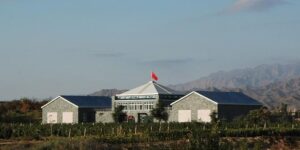
Helan Qingxue Winery (c)yengtravelguideroutes.com
2014 Jia Bei Lan Reserve. Drunk 2019. 100% Cabernet Sauvignon. On the first day, it still showed a lot of bulkiness and came out of the decanter back into the bottle. Two days later it turned up. On the nose, lots of ethereal freshness, menthol, camphor, also green undergrowth, and peppers are typical of Ningxia, which can be attributed to the relatively short growing season in this region. On the palate, Jiabeilan is less green than the nose would suggest. Nice spice, tart herbs with mugwort and wormwood herb to garrigue, little fruit but with a decent richness that prevents the wine from being too harsh. The tannin is present and firm but not too dominant. 91+/100
Chateau Changyu Moser XV:
This winery does not belong to the qualitative top in Ningxia for me, but since it is the best known in Europe, I want to mention it here. The Château is a gigantic, swanky Disneyland for Chinese wine drinkers. It was designed with Austrian winemaker Lenz Moser as a consultant and is Changyu’s flagship winery. Completed in 2013, the château is a grotesque caricature; it’s like the Neuschwanstein-inspired Cinderella Castle at Disneyland, except that it’s infinitely larger than its European counterparts. The wines at the base are solid and a joy to drink. At the top, they are overpriced and simply not great wines. 2017 Moser Italian Riesling (Welschriesling). Drunk 2019. floral, fruity bouquet with bright drops and white flowers. Quite appealing. Fresh, with some citrus and a touch of pleasant shellfish, it lingers very briefly on the papillae. Very nice, nicely drinkable, quite good for a simple white wine, but no more. 83/100 2016 Moser XV Cabernet Sauvignon. Drank in 2019. lots of green peppers and herbs on the nose. Lean on the palate, with a decent balance of fruit and distinct secondary flavors from the carefully proportioned wood. Mild tannins. A good boozy wine in red, not squeaky, not loud, not memorable. 83-84/100
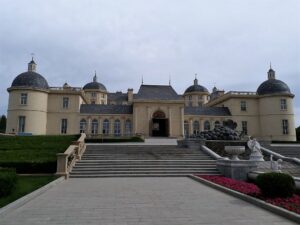
Pompous and of immense proportions: Chateau Changyu Moser XV bei Yinchuan (c)weinkellerschweiz.ch
2008 Moser Manor Tasting Wine Cabernet Sauvignon. Drank 2019. dried herbs, old wood, barely any fruit, a hint of cranberry. More spice and secondary flavors from the wood on the palate than fruit. A thin, drying body that can’t counter the tannins with enough flesh. Credit to the wine that it is not an alcohol bomb at 12.5%, yet it dispenses with residual sugar. The wine is drinkable, the dust-dry, wiry, brittle, reminiscent of a Travaglini Gattinara, has its charm. Nevertheless, he can not hold a candle to it by far. 84/100 2015 Moser Family Cabernet Sauvignon. Drunk in 2019. More power, unfortunately also significantly more alcohol. Cassis, red bell pepper. Some sweetness. Nice play of oriental spices, and tobacco. The tannins are inoffensive, the finish seems a bit green. A really good wine, but great enthusiasm does not arise. 89/100 2015 Ch. Changyu Moser XV Cabernet Sauvignon. Drunk in 2019. around 170 EUR ex winery. Spicy bouquet with little fruit (red currant), marked by secondary aromas, with bell pepper, rowan berry brandy, and also some tar like a Barolo. Lean body despite 15%, currently overwhelmed by the wood spice. A fine, ethereal menthol overtone is nice, making the wine seem cool and fresh. The tannins are noticeably predominantly from the wood and seem brittle and dry. A good wine that lacks harmony for proper greatness, it lacks fruit to keep the wine from drying out as the tannins melt away, and its body is too lean to integrate the spice from the wood. It may be closed at the moment, but for 170 EUR, more is needed. 88+/100

